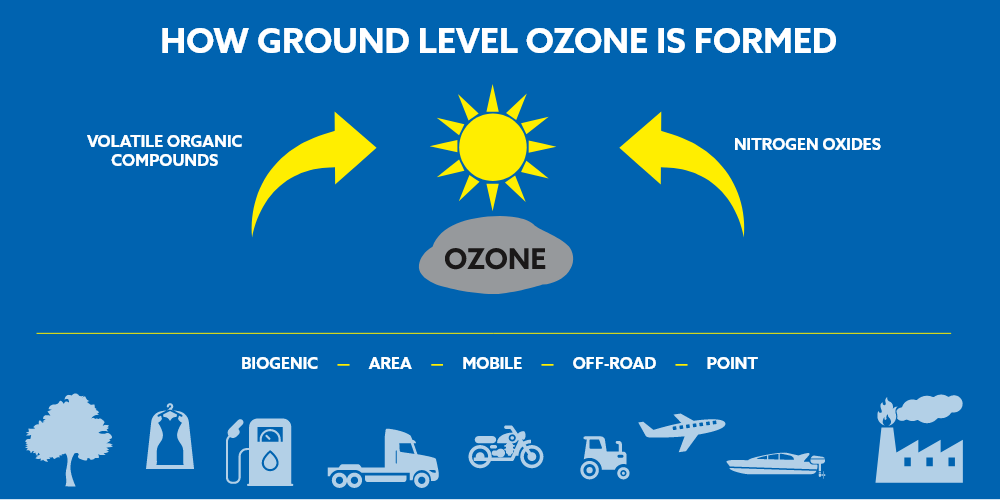
About Ozone
Ozone is an air pollutant that can irritate your throat and lungs, make it more difficult to breathe, provoke asthma attacks and damage the lining of your lungs.

Wait! I thought ozone was good for me!
It is—in the right place. Ozone molecules are more plentiful in the stratosphere—the layer of the atmosphere about 12 to 30 miles above the Earth's surface—where they absorb ultraviolet (UV) rays from the sun, protecting the Earth from this harmful radiation. But down here in the troposphere, where we all live and breathe, ozone turns from friend to foe, creating a dangerous health hazard when concentrations get high.
Where does all this ground-level ozone come from?
Pollution from cars, trucks, power plants, factories, paint, hairspray... a lot of the things we do and use every day contribute to the formation of ozone. Two kinds of pollution—nitrogen oxides (NOx) and volatile organic compounds (VOCs)—react when it's hot and sunny and produce ozone. Most NOx and VOCs come from cars, trucks and other vehicles and motors. This pollution can travel with the wind over long distances, creating air quality problems far downwind of pollution sources. This movement of pollutants over long distances is known as transport.
Who is most at risk from the dangers of ozone air pollution?
Some people are more sensitive to the effects of ozone. The groups most at risk are: 1) Active children, because they spend a more time outside playing hard and are more likely to have asthma. 2) Active adults, because vigorous outdoor work or exercise exposes them to more ozone. 3) People with respiratory disease, because diseases like asthma make the lungs more open to the damaging effects of ozone. 4) Those with unusual sensitivity, some healthy adults are more susceptible to the effects of ozone for no obvious reason.
How can I protect my health?
Because it takes hot, sunny weather to make a lot of ozone, we call the period from May-September "Ozone Season." During those months, keep yourself informed about ozone levels. The US Environmental Protection Agency, your state environmental agency and even some weather reports provide current and forecasted ozone levels. (Check out our "Resources" section for additional information available online.) Try to plan outdoor activities when the air quality forecast is good. When air pollution reaches moderate and unhealthy levels, try to limit outdoor exertion when possible.
How can I reduce pollution?
Much of the pollution that results in ozone formation comes from activities we do every day, such as driving and using electricity. Some ways we can reduce our contribution to the problem are: -Cars—carpool, use public transportation, reduce trips, walk or bike (on good air quality days), keep your car maintained and your tires properly inflated, gas-up after 6 p.m. Electricity—turn off unneeded lights and appliances; raise the A/C temperature a few degrees; replace incandescent light bulbs with compact fluorescents; purchase energy-efficient appliances and electronics. Products—avoid charcoal starter fluid; purchase low- or no-VOC paints, solvents and stains; use a spill-proof gas can; use electric or human-powered lawn equipment.
